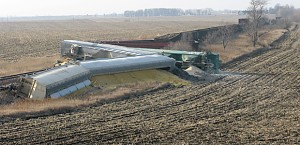CHARLES CITY, Iowa -- Investigators are trying to determine what caused 13 train cars to derail in Iowa.
The Mason City Globe Gazette ( http://bit.ly/rzy7AQ) reports the derailment happened just before 1 p.m. Saturday in Charles City in northeast Iowa. No injuries were reported.
The cars of the Canadian Pacific train were carrying soybeans and scrap metal when they toppled off the tracks at a stretch near state Highway 14. The train was bound for the northeast Iowa town of Marquette.
Railroad spokesman Ed Greenberg says an extensive investigation is being started to determine what caused the derailment. He says the railroad is also conducting "an appropriate response" that includes cleaning up the derailed cars.


You need to be a member of Earth Changes and the Pole Shift to add comments!
Join Earth Changes and the Pole Shift